Present in United Kingdom
Reportable – see ‘Report a sighting’ below
Scientific name of causal agent – Sirococcus tsugae
Sirococcus blight is a disease of cedar and hemlock trees (trees in the Cedrus and Tsuga genera respectively). It is caused by the Sirococcus tsugae fungus, and its main symptoms are severe shoot blight and defoliation.
Distribution
Until recently S. tsugae was only recorded in western North America, where it occurs on several species of hemlock and cedar trees. It has now also been confirmed in Georgia and north-eastern states of the USA.
It was first reported in the UK in 2014 and 2015, when it was found at a range of locations in England, Scotland and Wales, and since then also in Northern Ireland. Forest Research’s Tree Health Diagnostic and Advisory Service (THDAS) identified the fungus Sirococcus tsugae as the cause of the disease.
It was also first reported in Germany in 2014.
Susceptible species
Sirococcus tsugae infection has been confirmed on Atlas cedar (Cedrus atlantica), Himalayan cedar (C. deodara), cedar of Lebanon (C. libani), Cyprus cedar (C. brevifolia), western hemlock (Tsuga heterophylla), mountain hemlock (T. mertensiana) and eastern hemlock (T. canadensis).
It is reported that it appears to be less aggressive on eastern hemlock than on western hemlock.
The threat
Cedar and hemlock species are valuable ornamental and forestry species respectively in the UK. It could cause considerable damage to valuable ornamental trees in public and private gardens, and economic losses, in particular for the nursery sector.
Identification and symptoms
Cedars have needles arranged spirally on the young leading shoots, and in whorls on short spur-like side-shoots. In the spring, affected trees display dead needles on the shoots, dead shoots (Figure 1, below left), cankers (Figure 2, below right) and gum exudation.
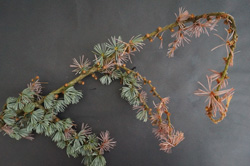 |
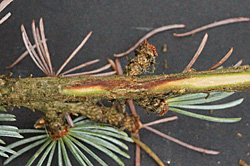 |
The dead needles are very distinctive as they have a characteristic ‘pink’ colour (Figure 3, below left) and only become brown as the season progresses. The fruiting bodies of S. tsugae may be observed on the dead needles (Figure 4, below right).
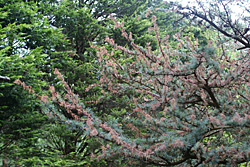 |
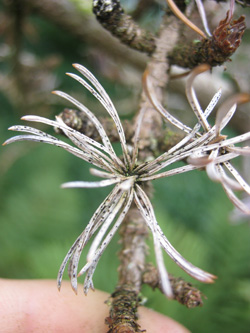 |
Affected branches can display canker. However, these are often indistinct and characterised by a slight reduction in branch diameter together with a change of bark colour from green to a darker red / purple (Figure 5, below left). Resin bleeding from the bark can also accompany these symptoms in some cases (Figure 6, below right).
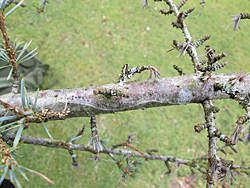 |
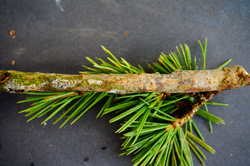 |
The fruiting bodies of S. tsugae may be seen on the surfaces of cankers during the winter months and into the spring (Figure 7, below left). Branches can die if they are girdled (Figure 8, below right).
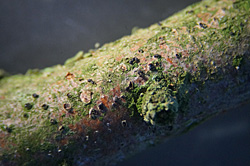 |
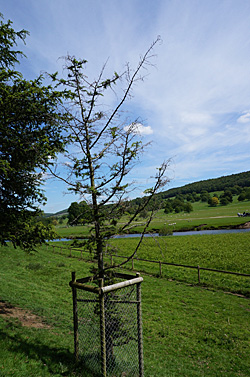 |
Brown lesions are evident in the phloem tissue of the bark (Figure 9, below left) and can extend from affected shoots into the subtending branches and the main stem, where they can spread longitudinally (Figure 10, below right).
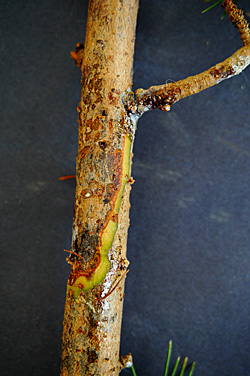 |
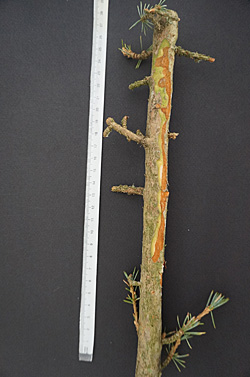 |
On western hemlock the disease is especially apparent in natural stands on advanced regeneration in the understorey (figure 11 – below left). It can affect one or many shoot tips on a single tree (figures 12 and 14, below right and lower right). On T. mertensiana the fungus causes shoot blight (figure 13, lower left).
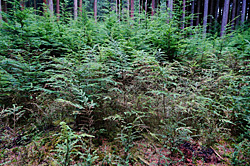 |
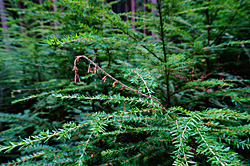 |
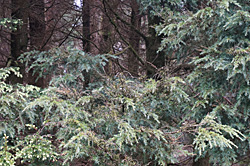 |
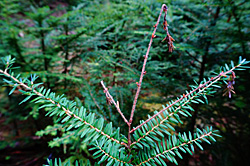 |
Report a sighting
If you suspect a case of Sirococcus blight in Great Britain, please report it to us with TreeAlert.
Report suspected sightings in Northern Ireland with TreeCheck, the all-Ireland tree disease reporting tool.
Spread
The conidia of the fungus are locally dispersed by rain splash and it is probable that strong winds can disperse them over longer distances. Seed transmission has been reported for S. conigenus, but there is no information about the potential for transmission of S. tsugae via seeds.
Pathways for spread include planting stock and possibly also cut foliage and seeds of cedar and hemlock trees from countries where the fungus occurs.
Management and control
No effective control measures against Sirococcus blight in forest stands have been reported from North America to date, and information about possible control methods in nurseries or in parks and gardens is scarce: it is mainly confined to biosecurity, or plant hygiene, measures to prevent or minimise spread.
Information about recommended biosecurity measures is presented on the UK Government website.
Origins and background
Until recently, the fungus responsible for dieback of cedar in Britain would have been regarded as belonging to the species Sirococcus conigenus (synonym Sirococcus strobilinus). However, research published in 2008 revealed that S. conigenus consisted of a group of closely related species as follows:
- S. conigenus sensu stricto, which occurs in Europe and North America, with many conifer hosts throughout the Northern Hemisphere. It was first described on Norway spruce (Picea abies) in Central Europe in 1890, and has subsequently been reported on a wide range of conifers, mainly in the spruce (Picea), pine (Pinus), larch (Larix) and cedar (Cedrus) genera. There have also been reports from Morocco and elsewhere in North Africa. This is a well known pathogen in nurseries, but can also occur in young plantations and mature stands;
- S. tsugae; and
- S. piceicola, which is known to occur on Norway spruce, white spruce (P. glauca) and Sitka spruce (P. sitchensis). It has been reported from three widely distributed geographic areas: eastern Canada, western Canada and Switzerland.
Related materials
- Forest Research Pathology advisory note 17 on Sirococcus blight
Contacts
- Ana Perez-Sierra (England and Wales)
- Steven Hendry (Scotland)
References
Rossmann AY, Castlebury LA, Farr DF, Stanosz GR (2008) Sirococcus conigenus, Sirococcus piceicola sp. nov. and Sirococcus tsugae sp. nov. on conifers: anamorphic fungi in the Gnomoniaceae, Diaporthales. Forest Pathology 38 (1), 47-60.
Smith DR, Stanosz GR (2008) PCR primers for identification of Sirococcus conigenus and S. tsugae, and detection of S. conigenus from symptomatic and asymptomatic red pine shoots. Forest Pathology 38 (3), 156-168.
Stanosz GR (2012) Sirococcus Shoot Blight. In: USDA Forest Nursery Pests Agricultural Handbook No. 680, 68-70.
Stanosz GR, Smith DR, Sullivan JP, Mech AM, Gandhi KJK, Dalusky MJ, Mayfield AE, Fraedrich SW (2013) Expansion in the known geographic distribution and host range of the shoot blight pathogen Sirococcus tsugae. Poster presented at the 24th USDA Interagency Research Forum on Invasive Species (Annapolis, US, 2013-01-08/11), p 95.
Stanosz GR, Smith DR, Sullivan JP, Mech AM, Gandhi KJK, Dalusky MJ, Mayfield AE, Fraedrich SW (2011) Shoot blight caused by Sirococcus tsugae on Eastern hemlock (Tsuga canadensis) in Georgia. Plant Disease 95 (5), 612-612.
